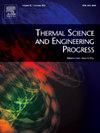波纹芯圆柱热管的性能分析
IF 5.1
3区 工程技术
Q2 ENERGY & FUELS
引用次数: 0
摘要
热管是高效的热管理系统,利用相变和毛细管作用以最小的热阻传递热量。本文研究了热管中芯-气界面几何形状对热管性能的影响。wick-vapor界面几何形状及其表面积对相变传热速率的影响尚未得到充分的研究。为了解决这一差距,本研究通过引入一种新型阶梯波纹芯设计来研究芯-蒸汽界面面积的增加对热管性能的影响。建立了二维有限元模型,并在稳态下进行了求解。灵敏度分析确定步距高度为关键参数。使用BOBYQA算法进行优化,蒸发器温度降低7.4 K,与相同芯体积的光滑芯热管相比,温度-压力指数提高131%。结果表明,对于特定的热输入,这种新型设计可将导热系数提高75%。这些发现突出了该设计在先进热管理应用中显著提高热管效率的潜力。本文章由计算机程序翻译,如有差异,请以英文原文为准。
Performance analysis of a cylindrical heat pipe with corrugated wick
Heat pipes are highly efficient thermal management systems that leverage phase change and capillary action to transfer heat with minimal thermal resistance. This study investigates the role of the wick-vapor interface geometry in the performance of a heat pipe. The impact of wick-vapor interface geometry and its surface area on phase change heat transfer rates remains insufficiently explored. To address this gap, the study investigates the influence of an enhanced wick-vapor interface area on heat pipe performance by introducing a novel stepped corrugated wick design. A two-dimensional finite element model is developed and solved at steady state. Sensitivity analysis identifies step height as the key parameter. Optimization using the BOBYQA algorithm yields 7.4 K reduction in evaporator temperature and an enhancement of 131 % improvement in Temperature-Pressure Index as compared to a smooth wick heat pipe of the same wick volume. The results show that the novel design increases thermal conductivity by up to 75 % for a particular heat input. These findings highlight the design’s potential to significantly enhance heat pipe efficiency for advanced thermal management applications.
求助全文
通过发布文献求助,成功后即可免费获取论文全文。
去求助
来源期刊

Thermal Science and Engineering Progress
Chemical Engineering-Fluid Flow and Transfer Processes
CiteScore
7.20
自引率
10.40%
发文量
327
审稿时长
41 days
期刊介绍:
Thermal Science and Engineering Progress (TSEP) publishes original, high-quality research articles that span activities ranging from fundamental scientific research and discussion of the more controversial thermodynamic theories, to developments in thermal engineering that are in many instances examples of the way scientists and engineers are addressing the challenges facing a growing population – smart cities and global warming – maximising thermodynamic efficiencies and minimising all heat losses. It is intended that these will be of current relevance and interest to industry, academia and other practitioners. It is evident that many specialised journals in thermal and, to some extent, in fluid disciplines tend to focus on topics that can be classified as fundamental in nature, or are ‘applied’ and near-market. Thermal Science and Engineering Progress will bridge the gap between these two areas, allowing authors to make an easy choice, should they or a journal editor feel that their papers are ‘out of scope’ when considering other journals. The range of topics covered by Thermal Science and Engineering Progress addresses the rapid rate of development being made in thermal transfer processes as they affect traditional fields, and important growth in the topical research areas of aerospace, thermal biological and medical systems, electronics and nano-technologies, renewable energy systems, food production (including agriculture), and the need to minimise man-made thermal impacts on climate change. Review articles on appropriate topics for TSEP are encouraged, although until TSEP is fully established, these will be limited in number. Before submitting such articles, please contact one of the Editors, or a member of the Editorial Advisory Board with an outline of your proposal and your expertise in the area of your review.
 求助内容:
求助内容: 应助结果提醒方式:
应助结果提醒方式:


